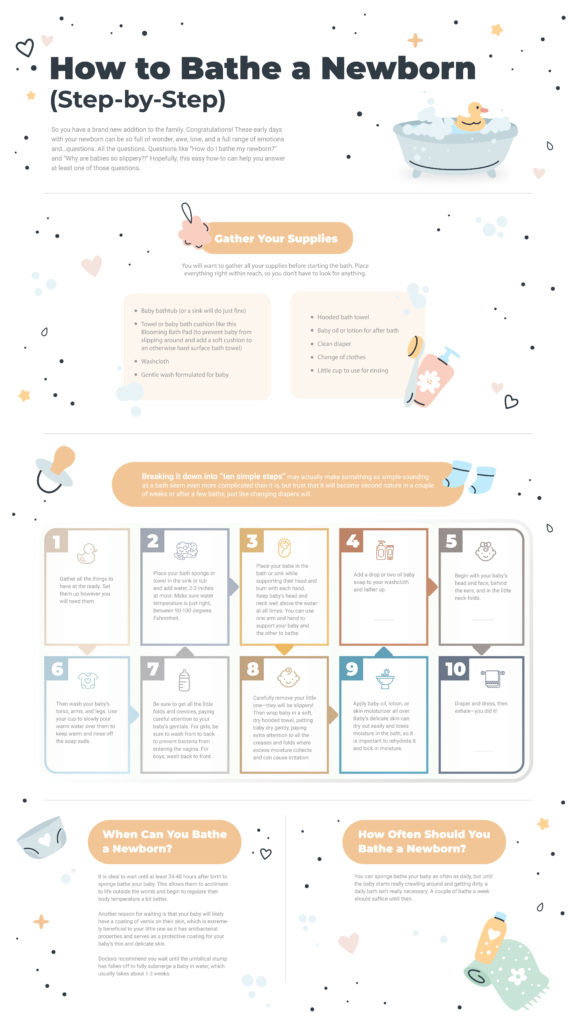So you have a brand new addition to the family. Congratulations! These early days with your newborn can be so full of wonder, awe, love, and a full range of emotions and…questions. All the questions. Questions like “How do I bathe my newborn?” and “Why are babies so slippery?!” Hopefully, this easy how-to can help you answer at least one of those questions.
First and foremost: Don’t panic. Bathing your newborn is not as tricky as it seems. These simple steps will help prepare you for your baby’s first (and subsequent) baths. Soon enough, bathing your baby will become second nature to you, like changing diapers.

Gather Your Supplies
You will want to gather all your supplies before starting the bath. Place everything right within reach, so you don’t have to look for anything.
- Baby bathtub (or a sink will do just fine)
- Towel or baby bath cushion like this Blooming Bath Pad (to prevent baby from slipping around and add a soft cushion to an otherwise hard surface bath towel)
- Washcloth
- Gentle wash formulated for baby
- Little cup to use for rinsing
- Hooded bath towel
- Baby oil or lotion for after bath
- Clean diaper
- Change of clothes
Choose the Location for the Bath

Should you bathe your baby in the kitchen sink or the bathtub? This is a personal choice, and it really just depends on what works for you in current circumstances.
Sink
Many parents choose the sink to bathe their baby in the early days for several reasons:
- One such reason is that it can be much easier on Mom, who’s presumably just given birth, to bathe baby in the sink while standing, rather than kneel down and lean over a tub, which can be quite uncomfortable for Mom, especially after a Cesarean section.
- Sink bathing makes it easy to have all your supplies at the ready, as you can lay them out right next to the sink basin on the countertop, well within reach.
If you go this route, be sure to clean your sink thoroughly before using it as a bath, being mindful of the product(s) you use to clean it so as not to irritate the baby’s skin.
Having that bath flower or sponge, or hand towel, to lay in the sink to prevent slipping will really come in handy. The bath flower is ideal because it can fit the shape of the sink, and the petals of the flower can nestle the baby’s body and prevent contact with the hardness of the sink.
Baby Bath
If you use a baby bath, you can easily use the bath flower, mat, or towel in much the same way. You can just set your baby bath within your bathtub and fill it with a little water. Simple!
Bathe with Baby in the Tub
Another option to consider is bathing with your baby. Many parents find this method a relaxing way to nurture the skin-skin contact and bonding period with their newborns.
If you’d like to go this route, again, be sure you have your towels and washcloths ready tub-side. Match tub water to your body temperature, don’t fill the tub too high, and be sure you get in first. Then have your partner hand your baby to you.
You may even want to wear bath gloves to give you a better grip on that slippery newborn. If you are breastfeeding, try nursing your baby in the bath. Skip the soap and just use the warm water to gently clean your baby.
Bathing Your Newborn
The purpose of these steps is so that you can be fully prepared for your baby’s bath routine, including the post-bath routine, before getting sudsy, because once you begin, you won’t be able to step away to grab that thing you forgot.
Breaking it down into “ten simple steps” may actually make something as simple-sounding as a bath seem even more complicated than it is, but trust that it will become second nature in a couple of weeks or after a few baths, just like changing diapers will.
- Gather all the things to have at the ready. Set them up however you will need them.
- Place your bath sponge or towel in the sink or tub and add water, 2-3 inches at most. Make sure water temperature is just right, between 90-100 degrees Fahrenheit.
- Place your babe in the bath or sink while supporting their head and bum with each hand. Keep baby’s head and neck well above the water at all times. You can use one arm and hand to support your baby and the other to bathe.
- Add a drop or two of baby soap to your washcloth and lather up.
- Begin with your baby’s head and face, behind the ears, and in the little neck folds.
- Then wash your baby’s torso, arms, and legs. Use your cup to slowly pour warm water over them to keep warm and rinse off the soap suds.
- Be sure to get all the little folds and crevices, paying careful attention to your baby’s genitals. For girls, be sure to wash front to back to prevent bacteria from entering the vagina. For boys, wash back to front.
- Carefully remove your little one—they will be slippery! Then wrap baby in a soft, dry hooded towel, patting baby dry gently, paying extra attention to all the creases and folds where excess moisture collects and can cause irritation.
- Apply baby oil, lotion, or skin moisturizer all over. Baby’s delicate skin can dry out easily and loses moisture in the bath, so it is important to rehydrate it and lock in moisture.
- Diaper and dress, then exhale—you did it!
Safety Tip: Do not turn your back on the baby while in the bath, not even for a second. Never leave your baby unattended in the bath or near the bath. You should also take caution that your water temperature is not too hot or too cold.
When Can You Bathe a Newborn?

It is ideal to wait until at least 24-48 hours after birth to sponge bathe your baby. This allows them to acclimate to life outside the womb and begin to regulate their body temperature a bit better.
Another reason for waiting is that your baby will likely have a coating of vernix on their skin, which is extremely beneficial to your little one as it has antibacterial properties and serves as a protective coating for your baby’s thin and delicate skin.
Doctors recommend you wait until the umbilical stump has fallen off to fully submerge a baby in water, which usually takes about 1-3 weeks.
How Often Should You Bathe a Newborn?
You can sponge bathe your baby as often as daily, but until the baby starts really crawling around and getting dirty, a daily bath isn’t really necessary. A couple of baths a week should suffice until then.
However, it is important that you maintain some sort of daily hygiene routine for the baby. All those little creases and cracks and folds in their delicate skin are prone to irritation and infection if not kept clean and dry. There are easy ways to make sure your little one stays clean, such as baby micellar water and infant cleansing wipes.
Final Thoughts
There you have it—everything you need to know about how to give your newborn a bath. Before you know it, you’ll be a pro! And in the meantime, remind yourself that you can do this, and you are a great parent!
Recent Posts
Having twins can be scary, overwhelming, and hard. But, it's also beautiful, fun, and adorable! Let's focus on the positives with these cute and funny stories about raising twins. Comment which one...
Newborn photography is a beautiful way to capture the fleeting moments of your baby’s earliest days. These precious photos become cherished keepsakes, encapsulating the joy and tenderness of...
